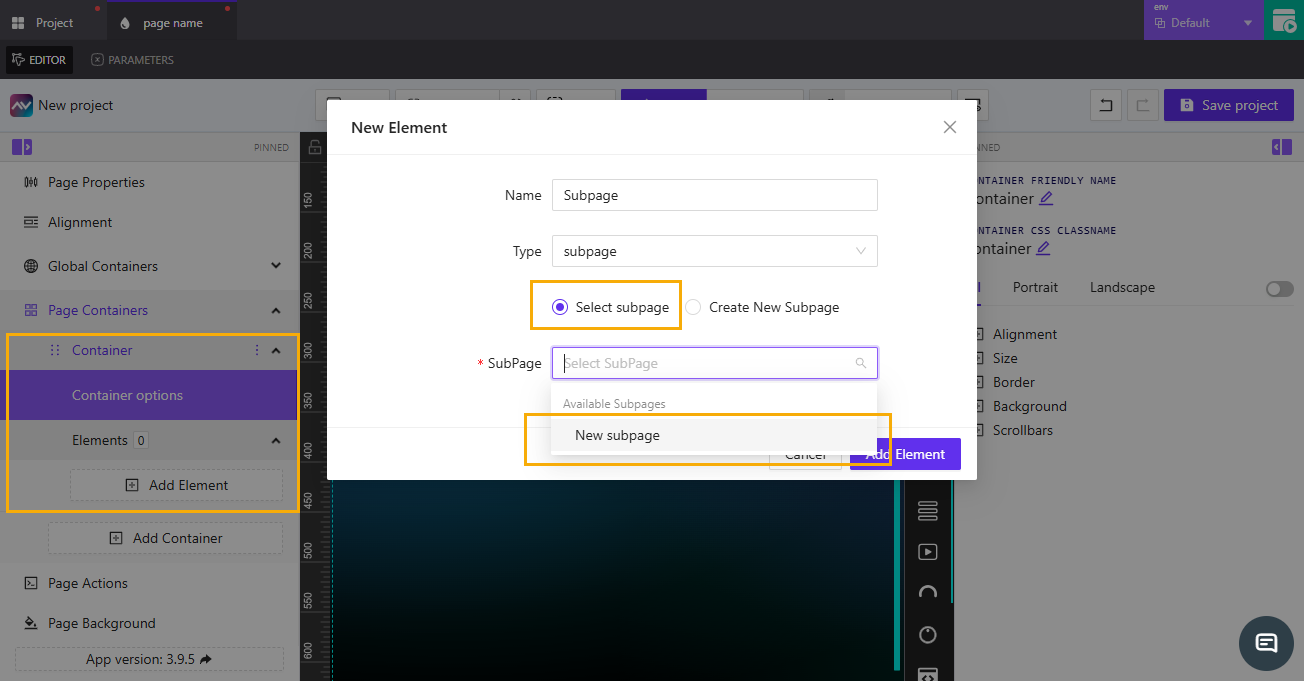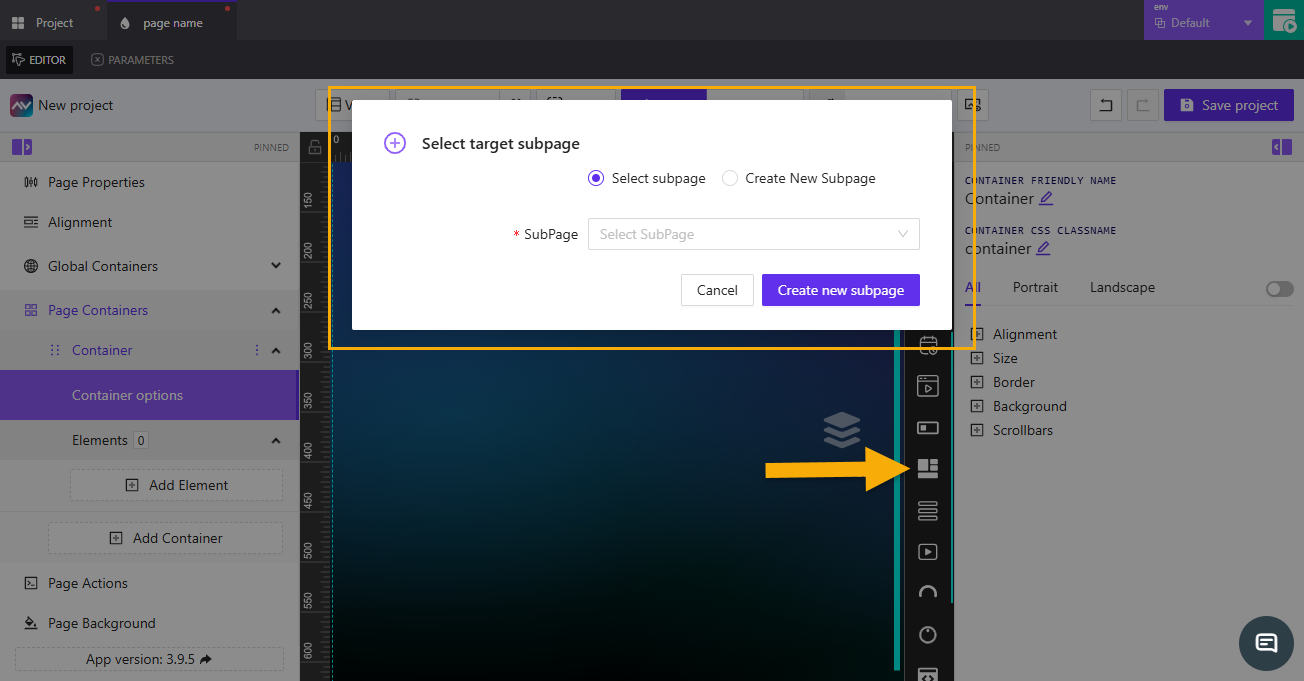Subpage
The Subpage element allows you to display separate pages or layouts within a project. Subpages are often used to organize complex interfaces, show popups, or dynamically load content within a defined area of the main layout.
Summary:
This guide explains how to add a Subpage element in AVStudio and configure its data source, dimensions, design, and action behavior.
Adding a Subpage Element
There are several ways to add a Subpage element in AVStudio.
1. From Page Containers
- Go to
ContainerunderPage Containers. - Click the dropdown arrow, select
Elements, and chooseAdd Element. - In the
Typedropdown, selectsubpage. - Choose whether to
Select subpageorCreate New Subpage.
When Create New Subpage is selected:
- Enter a name in the
New subpage namefield. - Choose a design paradigm:
AdaptiveorResponsive. - Click
Add Elementto create and add the new subpage.

When Select subpage is selected:
- Use the search bar to select from existing subpages in the project.
- Once selected, click
Add Elementto link it.
2. From the Editor
- Click the subpage icon from the toolbar on the right-hand side of the
Editor. - The
Select target subpagemodal opens. - Choose
Select subpageto link to an existing subpage, orCreate New Subpageto make a new one. - Click
Create new subpageto add it to the layout.

Subpage Properties
When the Subpage element is selected in the Editor, its properties appear on the right-hand panel in the order below.
Subpage friendly name
Specifies the name of the subpage. Click the edit icon to rename it. The name is used to identify the subpage across the project.
Subpage dataset source
Choose how the subpage receives data.
| Option | Description |
|---|---|
Static | Uses fixed data. No additional configuration. |
Dynamic | Opens Select datasource to work with, where a data source can be selected. |
Dimensions
Controls the size of the subpage container.
| Field | Description |
|---|---|
Width | Enter a value or use {-}. Default placeholder shows Inherits From Subpage. Units: px or %. |
Height | Enter a value or use {-}. Default placeholder shows Inherits From Subpage. Units: px or %. |
Mode selector by index or name
Selects a mode for the subpage using an index or a name.
- Enter a value directly, use
{-}, or clickfxto choose anAssign post-processing function.
Available subpage modes
Manage subpage modes.
Defaultis included automatically.- Click
+to openCreate new subpage mode, then set the mode name and options to add it.
Subpage CSS classname
Sets a CSS class for styling.
- Enter a class directly (default:
subpageElement), use{-}, or clickfxto select a post-processing function.
Parameters
Shows parameters exposed by the source subpage (read-only notice appears when none are available).
Example message: Source subpage New subpage doesn’t have parameters.
Appearance
Controls background, typography, and visual effects.
Background
| Setting | Description |
|---|---|
Background color | Pick a color or use {-}. |
Background elements blur | Adjust blur amount with the slider or numeric input. |
Font
| Setting | Description |
|---|---|
Font family | Choose a font (default Default). |
Font size | Enter a size or use {-}. Units: px. |
Border
Toggle between Default and Override to control border styling.
Shadow
Toggle None / Enabled to control shadow rendering.
Reflection
Toggle None / Enabled to add a reflection effect.
Content
Select the target subpage source.
| Setting | Description |
|---|---|
Select source (target subpage) | Choose Manual to pick from existing subpages, or Dynamic by name to link by name dynamically. |
Subpage picker (when Manual) | Choose the target from the dropdown (e.g., New subpage). |
State
Controls visibility and signal states for the subpage.
Visibility
| Setting | Description |
|---|---|
Orientation visibility | Show in Both, Portrait, or Landscape. |
Direct Value / Crestron FB | Control visibility directly or via Crestron feedback. |
Visibility dynamic value | Use {-} to bind a dynamic controller for visibility. |
Reserve space while hidden | Keep layout space when hidden. |
Disabled signal
Enter a signal name directly or use {-} to control when the subpage is disabled.
Actions
Adding a new action
- Click
Add new action. - The
Create new action for subpagemodal opens. - Configure:
Name— action name.Behaviour— when it runs (e.g.,On Change).Execution Delay— delay inms.
- Select a target tab:
Crestron,Routing,Variables,Parameters,Overlays,Functions,HTTP Web Requests,Web Sockets, orAudio. - Example (
Crestrontab):Type— e.g.,Push Digital.Signal Name— enter/assign.- Choose
Push onChange ValueorPush custom Value.
- Click
Create actionto save.
Key Points
- Use descriptive names for subpages for easier project tracking.
- Set
Dynamicdataset sources for data-driven layouts. - Use
AdaptiveorResponsivedesign paradigms based on screen orientation needs. - Keep reflections and shadows simple for better performance.
Frequently Asked Questions (FAQ)
What’s the purpose of a Subpage in AVStudio?
Subpages allow modular design by displaying sections or layouts within a container. This helps manage complex projects efficiently.
Can I reuse the same Subpage across multiple pages?
Yes. You can link a single subpage to multiple parent containers, allowing shared or dynamic content.
What’s the difference between Adaptive and Responsive?
Adaptive uses fixed layouts optimized for set screen sizes, while Responsive adjusts dynamically based on resolution and orientation.